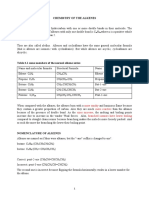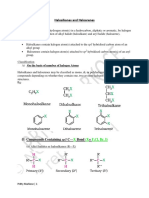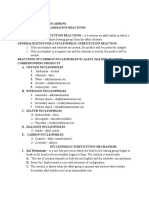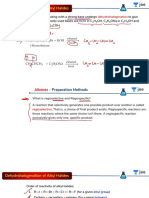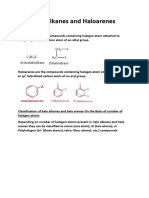Note Haloalkanes
Note Haloalkanes
Uploaded by
Nabin JoshiCopyright:
Available Formats
Note Haloalkanes
Note Haloalkanes
Uploaded by
Nabin JoshiCopyright
Available Formats
Share this document
Did you find this document useful?
Is this content inappropriate?
Copyright:
Available Formats
Note Haloalkanes
Note Haloalkanes
Uploaded by
Nabin JoshiCopyright:
Available Formats
Haloalkanes:
Physical Properties
1. Physical state
State: Lower members CH3Cl, CH3CH2Cl, CH3Br are gaseous, other alkyl halide up to C18 are liquid
and beyond C18 are solid.
Color: Colorless
2. Solubility
Even the C – X bond in haloalkane in polar in nature but due to inability to form intermolecular H-bond.
They are insoluble in water.
They mainly dissolve in organic solvents like, alcohol, ether, benzene etc.
3. Boiling Point
Haloalkanes have higher boiling point than corresponding alkanes.
I) for same alkyl group but different halogen atom, increasing order of boiling point is
RCl< RBr <RI
because with increase in the size and mass of halogen atom, magnitude of van der Waal’s force of attraction
increases and boiling point also increases.
Example: CH3CH2Cl < CH3CH2Br < CH3CH2I
II) For different alkyl group but same halogen atom (i.e. for Isomeric alkyl halide) , Boiling point
decrease with the increase in the branching in alkyl group because with the increase in branching, the
haloalkane molecule attain spherical shape with less surface area thus strength of van der Waal’s
force of attraction also decreases and boiling point also decreases.
Example:
Chemical Properties
Haloalkanes are highly reactive organic compounds. They mainly undergo substitution, elimination and reduction
reactions. Also, they react with metals and form organometallic compounds.
(A) Nucleophilic substitution reactions in Haloalkanes:
The C – X bond in haloalkane is polar in nature. Since halogen atom is more electronegative as compared
to carbon. Hence the C - atom to which halogen is present is electron deficient in nature. Therefore it is a
good site for a nucleophile to attack. Infact, the nucleophilic substitution reactions are the most common
reactions for Haloalkanes.
Haloalkanes undergo nucleophilic substitution reactions by two mechanism;
i. SN1 Mechanism
1|P age© Jay P rakas h P audel || Depart m ent of Chemi st ry
It refers to unimolecular nucleophilic substitution reaction. In SN1 mechanism, the rate of reaction depends
upon the concentration of only haloalkane.
Rate = K [ Haloalkanes]
This reaction mechanism proceeds through two steps; (i) Heterolytic fission of C – X bond which results
the formation of carbocation.
ii. The nucleophile then attach the carbocation and results the substituted product.
The order of reactivity in Haloalkane for SN1 reaction follows the order;
ii. SN2 Mechanism:
It refers to bimolecular nucleophilic substitution reaction. In SN2 mechanism, the rate of reaction depends
upon the concentration of both haloalkanes and the nucleophile.
Rate = K [ Haloalkanes] [Nucleophile]
Here, the attack of the nucleophile and the removal of halogen atom takes place simultaneously.
The order of reactivity in haloalkane for SN2 reaction follows the order;
2|P age© Jay P rakas h P audel || Depart m ent of Chemi st ry
Examples of Nucleophilic substitution reactions
1. Reaction with aq. NaOH or aq. KOH or with moist Ag2O
Haloalkanes when heated with aq. NaOH, aq. KOH, or moist silver oxide give the corresponding
monohydric alcohols.
R X + aq. NaOH R OH + NaX
Example:
CH3 CH2 Br + aq. NaOH CH3 CH2 OH + NaBr
Bromoethane Ethanol
Note: Moist Ag2O + H2O 2AgOH, it can produce –OH nucleophile.
2. Reaction with alcoholic KCN solution
When a haloalkane is allowed to react with an alcoholic KCN solution, an alkanenitrile is obtained.
It is one of the best method to increase a carbon atom in an organic compound.
Alkanenitriles are used for the synthesis of various organic compounds.
Example:
i. Partial Hydrolysis of alkanenitriles in the presence of conc. HCl gives an amide.
O
conc. HCl II
R – C N + H2O R – C – NH2
Alkanamide
ii. Complete hydrolysis of alkanenitriles with the help of dil HCl or H+/H2O gives carboxylic acid.
O O
H2O / dil HCl II H2O / dil HCl II
R – C N R – C – NH2 R – C – OH
Amide Carboxylic acid
3|P age© Jay P rakas h P audel || Depart m ent of Chemi st ry
iii. Reduction of alkane nitriles by LiAlH4 or Zn / HCl or Na / C2H5OH etc. give 1° amine.
LiAlH4
R – C N + [H] R – CH2 – NH2
1° amine
Note: Reduction of nitriles to 1° amine with the help of Na and C2H5OH is referred as Mendius
reaction.
3. Reaction with silver cyanide (AgCN)
When a haloalkane is allowed to react with an alcoholic solution of AgCN, an isocyanide is obtained.
An isocyanide on reduction with the help of LiAlH4 gives 2° amine.
LiAlH4
C + [H]
CH3 – CH2 – N = CH3 – CH2 – NH – CH3
ethyl isocyanide Ethyl methyl amine
(2° amine)
Ambident Nucleophiles
The word ambident is derived from two Latin words. ambi = on both sides and dens = tooth. Thus, an
ambident nucleophile has teeth on two sides. This means, it can attack from two different orientations to
give two different products.
Those nucleophiles which can attack the electron deficient centre through two possible sites to give two
different products are called ambident nucleophiles.
Examples:
4. Reaction with potassium nitrite (KNO2)
When a haloalkane is allowed to react with an aqueous solution of KNO2, alkyl nitrite is obtained.
4|P age© Jay P rakas h P audel || Depart m ent of Chemi st ry
5. Reaction with silver nitrite (AgNO2)
When a haloalkane is allowed to react with an alcoholic solution of AgNO2, a nitroalkane is obtained.
⊝⊕
6. Reaction with sodium alkoxide (RO Na)
When a primary haloalkane is allowed to react with alcoholic solution of sodium or potassium alkoxide,
an ether is obtained.
This reaction is referred as Williamson synthesis reaction.
Therefore, Williamson synthesis reaction is applicable for the synthesis of both symmetrical as well as
unsymmetrical ether.
7. Reaction with ammonia (NH3)
When a haloalkane is allowed to react with an alcoholic solution of NH3 at about 100°C temperature, a
mixture of 1°, 2°, 3° and 4° amine is obtained.
This reaction is called Hoffmann's ammonolysis reaction.
If haloalkane is excess,
5|P age© Jay P rakas h P audel || Depart m ent of Chemi st ry
Note:
Tetra-alkyl ammonium ion (R4 N) is referred as 4° amine.
8. Reaction with potassium hydrosulphide (KSH)
When a haloalkane is allowed to react with sodium or potassium hydrosulphide, an alkanethiol (alkyl
thioalcohol) is obtained.
9. Reaction with sodiumalkanethionate (NaSR)
When a haloalkane is allowed to react with sodium or potassium alkanethionate, a thioether is obtained.
B. Reaction with metals
1. Reaction with sodium (Wurtz reaction)
When a haloalkane is allowed to react with sodium in presence of dry ether, an alkane having even number
of carbon atoms is obtained. This reaction is referred as Wurtz reaction.
Especially this process is useful for the synthesis of an alkane having even number of carbon atoms. But,
if a mixture of two different haloalkanes are taken then an alkane with odd number of carbon atoms is also
obtained. But the percentage of yield is quite low.
E.g.
6|P age© Jay P rakas h P audel || Depart m ent of Chemi st ry
3° haloalkanes donot undergo this reaction, because instead of undergoing wurtz reaction, 3° haloalkanes
undergo dehydrohalogenation reaction in presence of strong base eg Na.
This reaction is useful for the preparation of higher symmetrical alkanes.
C. Elimination reaction (Dehydrohalogenation)
Dehydrohalogenation is an example of elimination reaction.
When a haloalkane is heated with an alcoholic solution of KOH or NaOH an alkene is obtained due to
dehydrohalogenation.
e.g.
The order of reactivity of different haloalkanes towards elimination reaction is given by,
3° haloalkane > 2° haloalkane > 1° haloalkane
Saytzaff's rule
If more than one products are obtained during dehydrohalogenation of a haloalkane, then the major product
is given by saytzaff's rule.
This rule states, during dehydrohalogenation of a haloalkane, if more than one products i.e. alkenes are
obtained, then the highly substituted alkene is the major product.
Eg.: Dehydrohalogenation of 2-chlorobutane gives two products i.e. but-1-ene and but-2-ene.
Out of these two products but-2-ene is highly substituted alkene. Hence, it is the major product according
to Saytzaff's rule.
D. Reduction reaction
When a haloalkane is reduced by Zn/HCl or HI/red P or Na/C2H5OH or H2/Ni or LiAlH4 etc, alkane is
obtained.
7|P age© Jay P rakas h P audel || Depart m ent of Chemi st ry
You might also like
- Unit 14 HydrocarbonsDocument63 pagesUnit 14 Hydrocarbonsnischalghising16100% (1)
- M-6 Reagent MSDSDocument26 pagesM-6 Reagent MSDSDorisjuarsa Sms100% (1)
- All The Tenses PDFDocument13 pagesAll The Tenses PDFNabin JoshiNo ratings yet
- Colibri Premium Butane Fuel Refill - 3 Large Cans (300mL Each)Document14 pagesColibri Premium Butane Fuel Refill - 3 Large Cans (300mL Each)KeyNo ratings yet
- Modern Physics Formula SheetDocument4 pagesModern Physics Formula SheetIntrovert xyz56% (9)
- Solution Tutorial No. 3 (Kinematics of Rigid Body)Document5 pagesSolution Tutorial No. 3 (Kinematics of Rigid Body)Genta AlamNo ratings yet
- Lecture CycloalkanesDocument21 pagesLecture CycloalkanesDain GutierrezNo ratings yet
- MLM XII ChemistryDocument57 pagesMLM XII ChemistryadaNo ratings yet
- Haloalkane and Haloarene 24-25 KVDocument16 pagesHaloalkane and Haloarene 24-25 KVMohammad PalekarNo ratings yet
- Bayer Test, Dan Bromine TestDocument18 pagesBayer Test, Dan Bromine TestBa'ist KhaerulNo ratings yet
- Unit 7-10 SM Theory Book 2 EM For 2022GRDocument19 pagesUnit 7-10 SM Theory Book 2 EM For 2022GRThilanka LiyanageNo ratings yet
- Naming Reactions & ReagentsDocument36 pagesNaming Reactions & Reagentscsksugan25No ratings yet
- Haloalkanes and HaloarenesDocument12 pagesHaloalkanes and Haloarenesmdevdharshan07No ratings yet
- Alkenes and AlkynesDocument22 pagesAlkenes and AlkynesAyodele AdeyonuNo ratings yet
- Chemistry Sample - Class 12Document20 pagesChemistry Sample - Class 12rajharshit3603No ratings yet
- Haloalkane Part I New Syllabus 1.Document16 pagesHaloalkane Part I New Syllabus 1.grgrohit1424No ratings yet
- Halo - NotesDocument13 pagesHalo - NotesGuestNo ratings yet
- Gr12 .UNIT 6.HALOALKANES AND HALOARENESDocument11 pagesGr12 .UNIT 6.HALOALKANES AND HALOARENESlitty0631No ratings yet
- Pdf-Haloalkanes and HaloarenesDocument159 pagesPdf-Haloalkanes and HaloarenesOmkar Singh Shekhawat100% (2)
- Chemistry Form 6 Sem 3 04Document44 pagesChemistry Form 6 Sem 3 04Ng Swee Loong StevenNo ratings yet
- Haloalkanes and Haloarenes NotesDocument18 pagesHaloalkanes and Haloarenes NotesAnkitha shajiNo ratings yet
- Chemistry Notes for Class 12 Chapter 10 Haloalkanes and HaloarenesDocument16 pagesChemistry Notes for Class 12 Chapter 10 Haloalkanes and Haloarenesextollingmyself3No ratings yet
- Alchohols Phenols and EthersDocument5 pagesAlchohols Phenols and EthersPritika Yamini SaiNo ratings yet
- Hsslive - Chem-Chap-10-Alkyl Halides & Aryl Halides - ShyjaDocument12 pagesHsslive - Chem-Chap-10-Alkyl Halides & Aryl Halides - ShyjaAlbin LeniNo ratings yet
- Preparation of Alkyl HalidesDocument3 pagesPreparation of Alkyl HalidesreddygrNo ratings yet
- Hydrocarbons (Hints)Document2 pagesHydrocarbons (Hints)hchawla421No ratings yet
- Halogenalkanes: Unit 2 Chemistry C. Bailey PolackDocument23 pagesHalogenalkanes: Unit 2 Chemistry C. Bailey PolackBritney PattersonNo ratings yet
- HalogenoalkanesDocument16 pagesHalogenoalkaneskudec2008No ratings yet
- Halo AlkanesDocument92 pagesHalo AlkanesRaichal P BijuNo ratings yet
- Exp 10 Alkyl HalidesDocument18 pagesExp 10 Alkyl HalidesGeorge PiliposyanNo ratings yet
- Alkanes 2Document14 pagesAlkanes 2Hasen umerNo ratings yet
- Chemistry Form 6 Sem 3 Chapter 4Document44 pagesChemistry Form 6 Sem 3 Chapter 4Yuzamrah Awang Noh100% (1)
- Alkyl Halides - pdf234Document37 pagesAlkyl Halides - pdf234Fakhri ElabbarNo ratings yet
- Chemistry Formula Chapter10 Haloalkanes and HaloarenesDocument17 pagesChemistry Formula Chapter10 Haloalkanes and Haloarenessukhada34No ratings yet
- WK7 - Halogenated HCDocument10 pagesWK7 - Halogenated HCsam cuadraNo ratings yet
- 8 Alcohols-2 and EthersDocument24 pages8 Alcohols-2 and EthersNova sounds - No copyright musicNo ratings yet
- Haloalkanes and Haloarene - NotesDocument14 pagesHaloalkanes and Haloarene - NotesPraneel BhattNo ratings yet
- Carbonyl CompoundsDocument25 pagesCarbonyl CompoundsLyana TaylorNo ratings yet
- Org 2Document30 pagesOrg 2rearachel25No ratings yet
- HaloalkanesDocument218 pagesHaloalkanesVidhan PatniNo ratings yet
- Haloalkane and HaloareansDocument16 pagesHaloalkane and HaloareansAbhianv Gupta100% (1)
- Name Eactions FinalDocument33 pagesName Eactions FinalAli Akand AsifNo ratings yet
- Useful Reactions PDFDocument8 pagesUseful Reactions PDFagusrimbombanteNo ratings yet
- Class 12 Haloalkanes NotesDocument13 pagesClass 12 Haloalkanes NotesIpsita SethiNo ratings yet
- Alcohol QPDocument22 pagesAlcohol QPjeejirajappan3starNo ratings yet
- Chemsitry Important Revision Notes For CBSE Class 12 Chapter 10Document20 pagesChemsitry Important Revision Notes For CBSE Class 12 Chapter 10himanshuchoudhary8534No ratings yet
- Reactions of HaloalkanesDocument10 pagesReactions of Haloalkanesapi-504683923No ratings yet
- Give Reason - Haloalkanes and Haloarenes (2024-2025)Document4 pagesGive Reason - Haloalkanes and Haloarenes (2024-2025)Sanjay SatheeshNo ratings yet
- Preparations and Reactions of AlkanesDocument25 pagesPreparations and Reactions of AlkanesCarlo Manguil100% (1)
- Alkyl HalideDocument30 pagesAlkyl HalideMalaika KhalidNo ratings yet
- GssDocument26 pagesGssvnikhar123100% (1)
- Alkyl Halides LectureDocument16 pagesAlkyl Halides LectureKoki KingNo ratings yet
- CHAPTER 6 Alkyl Halides and Aryl HalidesDocument150 pagesCHAPTER 6 Alkyl Halides and Aryl HalidesexpertwritersNo ratings yet
- HaloalkanesDocument13 pagesHaloalkanesChingYan TanNo ratings yet
- 32 DR Zhou Lecture 32 PDFDocument23 pages32 DR Zhou Lecture 32 PDFBUCH203No ratings yet
- Haloalkane 12Document11 pagesHaloalkane 12vittroshniNo ratings yet
- AlkenesDocument120 pagesAlkenesVidhan PatniNo ratings yet
- Haloalkanes and Haloarenes Notes PDFDocument18 pagesHaloalkanes and Haloarenes Notes PDFadib 8083No ratings yet
- Haloalkanes and HaloarenesDocument30 pagesHaloalkanes and Haloarenesaashidagur503No ratings yet
- Hydrocarbons SheetDocument38 pagesHydrocarbons Sheetpathalam subrahmanyamNo ratings yet
- Organic AssignmentDocument9 pagesOrganic AssignmentSaud AlamNo ratings yet
- Revised Organic ChemistryDocument90 pagesRevised Organic ChemistryMinh TieuNo ratings yet
- Halogen Compounds Alcohols and Ethers (Hints)Document4 pagesHalogen Compounds Alcohols and Ethers (Hints)Dev MahawarNo ratings yet
- Unit 2 Basics of C ProgrammingDocument57 pagesUnit 2 Basics of C ProgrammingNabin JoshiNo ratings yet
- Unit 1 Basic Discrete StructuresDocument38 pagesUnit 1 Basic Discrete StructuresNabin JoshiNo ratings yet
- Unit 5 InheritanceDocument35 pagesUnit 5 InheritanceNabin JoshiNo ratings yet
- Part 1 Fundamental Principle of Counting HandoutDocument4 pagesPart 1 Fundamental Principle of Counting HandoutNabin JoshiNo ratings yet
- Poly Halo Al KanesDocument3 pagesPoly Halo Al KanesNabin JoshiNo ratings yet
- Haloalkanes Upto IsomerismDocument3 pagesHaloalkanes Upto IsomerismNabin JoshiNo ratings yet
- Unit 7 Working Capital ManagementDocument36 pagesUnit 7 Working Capital ManagementNabin JoshiNo ratings yet
- LAB-QuestionsBBAF For Lab SheetDocument4 pagesLAB-QuestionsBBAF For Lab SheetNabin JoshiNo ratings yet
- Types of Investment CompaniesDocument5 pagesTypes of Investment CompaniesNabin JoshiNo ratings yet
- Unit 1 - Corporate Finance and Financial EnvironmentDocument29 pagesUnit 1 - Corporate Finance and Financial EnvironmentNabin JoshiNo ratings yet
- Chapter 14 ProbabilityDocument13 pagesChapter 14 ProbabilityNabin JoshiNo ratings yet
- Unit 2-Transmission MediaDocument6 pagesUnit 2-Transmission MediaNabin JoshiNo ratings yet
- Human Intelligence: PratimaDocument39 pagesHuman Intelligence: PratimaNabin JoshiNo ratings yet
- Test Papers A LevelDocument29 pagesTest Papers A LevelHuzaif RahimNo ratings yet
- MSC Module Manual, Physics, Heidelberg UniversityDocument95 pagesMSC Module Manual, Physics, Heidelberg UniversityHanif RahmaniNo ratings yet
- PPT Teknik PengaturanDocument16 pagesPPT Teknik Pengaturankapontori098No ratings yet
- RetrurnDocument8 pagesRetrurnTechnical A-Star Testing & Inspection MalaysiaNo ratings yet
- PPT1 CB X Sci Chemical Reactions and EquationsDocument20 pagesPPT1 CB X Sci Chemical Reactions and Equationsaditinandpal338No ratings yet
- 10 3 Reaction Engine CyclesDocument14 pages10 3 Reaction Engine CyclesSankara SubramanianNo ratings yet
- Temperature Events in CeramicDocument3 pagesTemperature Events in CeramicjamenI100% (2)
- Codigos de Error Climas ZartechDocument28 pagesCodigos de Error Climas Zartechscs.trefrig9614No ratings yet
- Gas Liquid SeparatorDocument34 pagesGas Liquid SeparatorayatbimaNo ratings yet
- Effect of Contamination Towards Proton Exchange Membrane Fuel Cell Performance: A Review On Modeling and Simulation WorksDocument12 pagesEffect of Contamination Towards Proton Exchange Membrane Fuel Cell Performance: A Review On Modeling and Simulation WorksBotol KosongNo ratings yet
- Band Structure and Transport Properties of Some 3-5 CompoundsDocument13 pagesBand Structure and Transport Properties of Some 3-5 CompoundsJose Leon GonzalezNo ratings yet
- Inorganic Polymers CBZ 2Document54 pagesInorganic Polymers CBZ 2Shrawani DeshmukhNo ratings yet
- MPEB Bilge Water SeparatorDocument162 pagesMPEB Bilge Water SeparatorMarek NiewiadomskiNo ratings yet
- Service Bulletin Trucks: Coolant RequirementsDocument13 pagesService Bulletin Trucks: Coolant RequirementsmattkidoNo ratings yet
- Corrosion prevention and control.docxDocument6 pagesCorrosion prevention and control.docxTO THE WORLDNo ratings yet
- Week6 11 Titration PHDocument99 pagesWeek6 11 Titration PH62100959No ratings yet
- PolymerDocument53 pagesPolymerAqilah AzmiNo ratings yet
- 3.28 & 3.29 Kawat Las Nikko Steel 312 2,6 X 350 MM & 3,2 X 350 MMDocument1 page3.28 & 3.29 Kawat Las Nikko Steel 312 2,6 X 350 MM & 3,2 X 350 MMumarNo ratings yet
- Minor Project 2Document18 pagesMinor Project 2patel2732sNo ratings yet
- Science Final 9 Test Bank QuestionDocument32 pagesScience Final 9 Test Bank QuestionKimNo ratings yet
- Hybrid Organic-Inorganic Structures For Solution Processed Organic Light Emitting Diodes - PDF RoomDocument159 pagesHybrid Organic-Inorganic Structures For Solution Processed Organic Light Emitting Diodes - PDF RoomBesharat KhaleidNo ratings yet
- Week 5 Chapter 40 Workbook Assignments HCR107-Air Conditioning Systems020102DGDocument7 pagesWeek 5 Chapter 40 Workbook Assignments HCR107-Air Conditioning Systems020102DGmichaelagu65No ratings yet
- Coordination Number in Liquid ArgonDocument10 pagesCoordination Number in Liquid Argon09187135911No ratings yet
- CH2043 - 5 - Natural ConvectionDocument27 pagesCH2043 - 5 - Natural ConvectionLong NguyenNo ratings yet
- Tugas Pertama Termodinamika Kelompok 1Document4 pagesTugas Pertama Termodinamika Kelompok 1Gita CristyNo ratings yet













